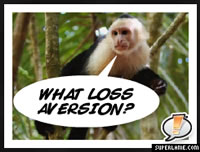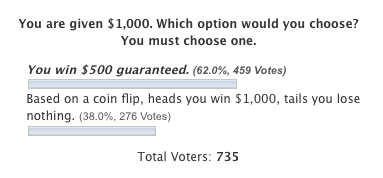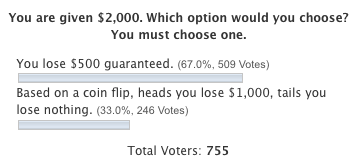 After two days of polling for my Are You Smarter Than a Monkey question, here are the results. As I revealed after voting, visitors were each served up one of two different poll questions randomly, with an equal chance of getting either one. This worked out pretty well, with 49%/51% split of voters.
After two days of polling for my Are You Smarter Than a Monkey question, here are the results. As I revealed after voting, visitors were each served up one of two different poll questions randomly, with an equal chance of getting either one. This worked out pretty well, with 49%/51% split of voters.


If you compare the questions side-by-side, you realize that they actually ask the exact same thing. Your two choices are essentially:
- $1,500 guaranteed, or a
- 50/50 chance at either $1,000 or $2,000
In statistics and gambling, there is a concept called expected value which is the probability-weighted sum of the possible values. In this case, the expected value for both options is $1,500. In other words, over many coin flips, the average person will get $1,500. So there is no “right” answer really, it’s more about how much risk you wish to take on. In general, you all would rather take the sure thing. I would be in this camp as well, but I’d probably take the risk if the expected value was a bit higher (remnants of blackjack self-training).
So if both polls are asking the same thing, a rational human being would answer both questions the same. However, psychologists have found that how the question is posed changes the answer. In the top poll, you start with $1,000 and are faced with either a sure gain or a bigger gain/nothing. In the bottom poll, you start with $2,000 and are faced with a sure loss or a bigger lose/nothing.
This small difference tries to test the phenomenon of loss aversion, which is the human tendency to strongly prefer avoiding losses rather than making gains. In this case, studies found humans hated the idea of losing $500 guaranteed so much that they’d take the risk in order to possibly avoid a loss, even though as we showed above the two choices are the same. Research with monkeys found that capuchin monkeys would also rather avoid the sure loss, indicating that this may be a genetic flaw rather than caused by our environment.
However, you guys were the complete opposite.
More people (38% versus 33%) went for the risky option when they had the $1,000. I don’t have any solid explanation for this, but here are some theories:
- Readers of this blog are exceptional and don’t have loss aversion, they are of the “nothing to lose anyway, let’s go for it” mindset.
- My testing was flawed. In the official studies, I am not sure if the same person was asked both questions, one after another. In retrospect, perhaps it would be better to present it in this manner.
- Readers were already aware of the loss aversion theory, and compensated when answering the poll.
- People either voted on both polls or multiple times on either poll, perhaps after reading the rest of the post explanation.
Either way, this was fun, and with nearly 1,500 voters, I’ll definitely try another experiment soon. 😉
 The Best Credit Card Bonus Offers – 2025
The Best Credit Card Bonus Offers – 2025 Big List of Free Stocks from Brokerage Apps
Big List of Free Stocks from Brokerage Apps Best Interest Rates on Cash - 2025
Best Interest Rates on Cash - 2025 Free Credit Scores x 3 + Free Credit Monitoring
Free Credit Scores x 3 + Free Credit Monitoring Best No Fee 0% APR Balance Transfer Offers
Best No Fee 0% APR Balance Transfer Offers Little-Known Cellular Data Plans That Can Save Big Money
Little-Known Cellular Data Plans That Can Save Big Money How To Haggle Your Cable or Direct TV Bill
How To Haggle Your Cable or Direct TV Bill Big List of Free Consumer Data Reports (Credit, Rent, Work)
Big List of Free Consumer Data Reports (Credit, Rent, Work)
I am sticking to my original theory. That the actual $$ amount plays a role in the decision making.
In this case my theory would be that for most of your readers $500 is a lot of money, so they’re going for the sure thing. I’d be interested to know if the risk takers were higher earners.
I would really be interested to what the answers would be if the $$ amount was an order of magnitude or two higher or lower. How would you vote for $1 bet vs $1MM bet.
I was one of the “nothing to lose anyway, let’s go for it”. This was fun. Do more!
My understanding of psychology suggests something else is in play here. Both monetary amounts might appear to be the same, but that’s not what we were asked to choose. We were asked to choose one of two bubbles to fill in. Choice A is short and easy to understand. Choice B was longer and more complicated, and took more time to understand what it meant. I think many people that thought the two choices were the same would gravitate toward the shorter and more clear choice.
In the same way, I think the words “lose $1000” (and even the words “lose nothing”) was a real turnoff for some people, so people were apt not to choose that. People are easily swayed based on wording, and I suspect that might be more of a factor than some might otherwise realize.
One thing to note – the $500 option is rationally preferred if you look at expected value in terms of utility rather than expected value in terms of dollars, due to diminishing marginal utility. That third $500 is of more value to me than that fourth.
Yawn!
Ok, people who read this blog are pre-disposed to saving money and answering this question this way. They have more aversion to risk just generally.
Also, knowing the perspective of this blog, I knew what the “right” answer was supposed to be, but I answered the way I really felt. I’ll bet not everybody did.
I saw this question given in a Ted.com talk: http://www.ted.com/talks/laurie_santos.html
Great idea to put it to the test!!
Did the age of the participants play a major role in their aversion to risk. I will go for “a bird in the hand is worth two in the bush” every time.
Sandy and David Thomas have the right idea to explain why more people chose the first option. There is risk aversion going on, but also a different utility. To observe this, change both amounts by a factor of 100 and see if it changes.
i.e. Sure 15 dollars vs 50% at 10 or 20.
or sure 150,000 versus a chance at 100,000 or 200,000.
More people would likely risk at the top choice due to it triggering their risk aversion less. 5 bucks will not buy that much, might as well enjoy the risk of “losing” another 5. Also, the utility of 5 dollars is not that high, so we don’t have to be factoring that in much, less is at stake.
On the bottom choice, taking the risk implies that we might be “losing” 50k! That’s a lot of money. Sure, I might make another 50k too, but that sure “3rd 50k,” as David put it, gets me further than the 4th one.
What nobody has commented on yet is the 38 vs 33% difference. I think the author missed exactly the point he was trying to make all along. In the 1st scenario, the second option was to gain 1k or *lose* _nothing_. On the 2nd scenario, the second option was lose nothing or *lose* _1k_. Being that we are *loss* averse, it stands to logic that we expect less people to choose an option which makes explicit that we can *lose* _1k_. Some people don’t calculate EV, so they don’t realize that options 1 and 2 are equal in both scenarios, thus part of the 5% difference. But the, say, 62:38% difference is pretty reasonable and I think show your readers’ demographics. The non-risky option at these 50% EV questions is usually a smarter choice in my opinion, unless you are a risk prone individual and take pleasure/utility from the gamble itself. The other potential explanation between the 38:32% difference might just be standard error; just calculate the confidence intervals to check if there is a significant difference between the two percentages.
This is an interesting topic, good job.
I’m telling you people, it’s all about the wording. Here are the 4 in order of popularity.
1. You win $500 guaranteed (sounds very appealing)
2. You lose $500 guaranteed (since the reader hasn’t had time to really celebrate his $2000 gain, this is really just “You win $1500 guaranteed, which is also good).
3. Based on a coin flip you win $1000 or lose nothing (change the wording to “you win an extra $1000 if you get heads, if tails you keep your $1000” and the votes change).
4. Based on a coin flip, heads you lose $1000, tails you lose nothing (worst possible solution, no matter what happens you “lose”. Change the wording to “you keep your $2000” and see what happens.
So to summarize, the results only tell you how difficult it is to do a fair experiment. In this case “guaranteed” was considered a better word than “lose”, and that made all the difference.
The thing you’re failing to take into account is that the human mind also tries to calculate the probability that the poll giver/payer is lying.
It’s easy to say something is “guaranteed” but for it to actually be a sure thing is another matter entirely. Psychologists never seem to grasp this simple and essential fact.
A guaranteed amount is always nice. The fear of loss plays a role in my decision. Even though the possible gain is nice, who needs the added stress and pressure of a coin flip? Heh heh…
Probably there is no significant difference between 38% versus 33% and that your test is flawed as the sample is not randomly selected from the population.